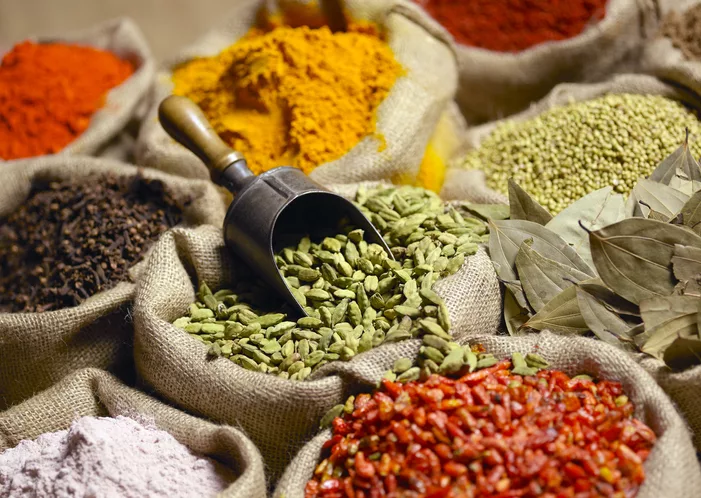The enduring allure of herbs and spices stretches across millennia, weaving a tapestry of both medicinal and culinary significance across cultures worldwide. Even in our contemporary lives, these botanical treasures continue to play an integral role, subtly enhancing the flavours of our cuisine and often serving as vital components in various products.
Given their profound impact, let us go on an exploration of the historical trajectory of herbs and spices, tracing their evolution through time, and examining the preeminence of certain varieties in global contexts.

Picture: Getty Images
Historical significance in medicine
From time-honoured herbal teas to the extraction of essential oils, herbs and spices have graced the annals of medicine for countless generations. In antiquity, their applications were rooted in the realm of medicinal properties, wherein components such as roots, berries, seeds, leaves, flowers, fruits, and bark were harnessed for therapeutic purposes. In an era preceding the advent of conventional pharmaceuticals, humanity relied heavily on these botanical substances to sustain well-being and combat ailments.
Archaeological insights reveal that the practice of herbal medicine can be traced back over 60 000 years to regions encompassing Iraq and China. Among the documented instances of these practices, laurel, caraway, and thyme stand as notable examples. Remarkably, the utilization of herbs and spices as an alternative to manufactured medications continues to thrive on a global scale.
Culinary applications and flavours
From a culinary standpoint, herbs and spices occupy a unique niche, offering nuanced flavours that elevate dishes to remarkable heights. While the quantities employed in culinary creations are often modest, their influence on taste is profound, rendering them indispensable components. Notably, indigenous herb gardens across various cultures have imparted their distinctive imprints on renowned dishes, thereby shaping culinary traditions.
The remarkable continuity from historical culinary practices to modern cuisine underscores the potency of these botanical agents in engendering distinctive flavors and aromas, intricately associated with their respective culinary heritages. The process of seasoning, guided by the ingenious selection and combination of herbs and spices, wields the transformative power to reshape gastronomic experiences.
Enabling culinary innovation
In contemporary culinary landscapes, innovation is paramount. Culinary establishments aiming to distinguish themselves in the competitive market are keenly aware of the imperative to experiment with herbs and spices. By infusing novelty into established recipes through the strategic deployment of these botanical agents, restaurants etch their identities with finesse. The harmonious interplay of herbs enriches flavors and fosters a diverse gustatory spectrum, enriching palates and eliciting admiration.
Beyond the realm of taste, these herbal additives yield additional dividends. When consumed as part of a balanced diet, they contribute a generous assortment of essential minerals and vitamins, thereby promoting holistic well-being.
Dried varieties
The dynamic interplay between fresh and dried herbs and spices is a facet worth exploring. The process of drying preserves the inherent potency of these botanicals, amplifying their flavors and aromas. Consequently, a reduced quantity of dried herbs is required to achieve comparable outcomes when compared to their fresh counterparts. The concentrated nature of dried specimens, resulting from the retention of volatile oils until subjected to heating or grinding, engenders a remarkable culinary experience.
This culinary strategy aligns with principles of sustainability and resourcefulness, as it curtails product consumption while minimizing food wastage, thereby contributing to a judicious utilization of resources.
Global Epitomes of Flavor
Culinary landscapes across the globe exhibit a rich tapestry of preference, with regional cuisines steeped in distinct seasonings and culinary techniques. A medley of herbs and spices is intrinsic to the characterization of authentic flavours and culinary identities.
Allow us to traverse the globe and acquaint you with some preeminent herbs and spices that have ingrained themselves in the heart of culinary traditions:
Pepper
Originating in Southeast Asia, peppercorns have served as both a flavouring agent and a traditional remedy for millennia. Among spices, black pepper holds the title for being the most globally traded, frequently enhancing dishes across various cuisines.
Chilli
Chilli peppers trace their origins to Bolivia and were initially cultivated in Mexico. Across diverse culinary traditions, they are prized for their capacity to infuse dishes with heat and zest. Capsaicin, the compound responsible for their fiery kick, offers a warm and invigorating sensation when ingested or utilized topically for medicinal objectives.
Nutmeg
Derived from the seeds of the aromatic nutmeg tree, this spice finds its roots in Indonesia. Known for its aromatic and warming profile, nutmeg features prominently in Indonesian cuisine, seasoning dishes like soto, konro, oxtail, sup iga, bakso, and sup kambing. Furthermore, nutmeg’s essence has been harnessed globally for essential oils and plays a significant role in perfumery.
Garlic
Native to central Asia and with a history of cultivation spanning over 4,000 years in Mesopotamia, garlic is celebrated globally for its robust flavour as a seasoning and condiment. Intriguingly, well-preserved garlic has been discovered in Tutankhamun’s tomb. In ancient Egypt, garlic held sacred and nutritional significance, believed to bestow health and joy upon those who consumed it. This versatile ingredient also boasts a rich history in traditional medicine across diverse cultures, including Egypt, Japan, China, Rome, and Greece.
Ginger
Originating once again in Southeast Asia, ginger’s early domestication can be traced among the Austronesian peoples, who cultivated various ginger species in ancient times. Possessing adaptability to diverse terrains, ginger thrives best in warm and humid climates. India took the lead in ginger production in 2019, contributing 44% to the global output.
Oregano
Although native to the Mediterranean, oregano has established itself in temperate regions across the Northern Hemisphere. Both oregano and its close relative marjoram are cherished culinary herbs, prominently featured in cuisines like Turkish, Greek, Spanish, Italian, Mexican, and French.
Rosemary
Hailing from the Mediterranean and Asia, rosemary is a fragrant evergreen shrub. Notably resilient, it can endure extended periods of drought. Special cultivars such as ‘Arp’ showcase impressive resilience, surviving temperatures as low as −20 °C. With a slow growth rate, rosemary plants can thrive for up to three decades.
Cinnamon
Derived from the inner bark of select Cinnamomum tree species, cinnamon has held significant value across ancient civilizations. It was so esteemed that it was considered an offering fit for deities. The trade origins of cinnamon were guarded as a closely held secret by Mediterranean spice traders to safeguard their monopoly.
Basil
Present in a wide array of global cuisines, basil is historically recognized for its role as an effective insect repellent. Native to tropical regions spanning Africa to Central Asia, basil’s annual nature is adapted to temperate climates.
Mint
Native to Eurasia, North America, southern Africa, and Australia, mint boasts a diverse family of 25 species. These have been dispersed across temperate regions and have naturalized in numerous locations. In ancient times, chewing mint leaves was thought to purify teeth and contribute to robust bone health, fostering longevity.
Follow us on social media for more travel news, inspiration, and guides. You can also tag us to be featured.
TikTok | Instagram | Facebook | Twitter
ALSO READ: Timeless plant-based traditions spanning the globe
















